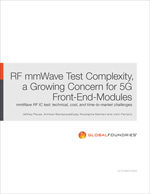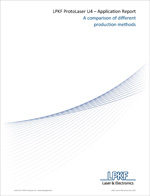Require Registration
November 15, 2019
Future technologies and standards will make over-the-air (OTA) testing mandatory. Measurement requirements will change and engineers need a basic understanding of antennas and antenna measurements. But how to get ready for OTA testing? Learn more with our extensive white paper.
November 15, 2019
High power amplifier combining has several unique challenges, this paper will show some of the advantages of using a complementary pair of 90-degree hybrids as the power dividing and combining network. In addition, advantages and tradeoffs this network configuration compared to the traditional in-phase networks will be detailed.
November 15, 2019
The Designer's Primer for IoT showcases recent advances in NI AWR software that help designers meet the challenges of developing cost-effective IoT solutions using a modular design approach that focuses on combining all the relevant components in the RF signal path.
November 15, 2019
The Outphasing, Doherty and Envelope architectures have been known for many decades. More recently, significant research and development effort has been directed at these schemes themselves and also variants that hybridize, or use two (or more) of these techniques. This document provides a starting reference, supported by working measurement examples.
November 11, 2019
This eBook looks at some key applications where oscilloscopes are best suited to make the key measurements to evaluate your designs. The first article examines practical printed circuit board design and manufacture to reduce noise by comparing two simple circuits and the resulting difference in their performance. The next article looks at triggering on radar RF pulses with an oscilloscope. And another article follows covering demodulating radar RF pulses with an oscilloscope. Then the eBook shares some tips about how to successfully perform low noise, sub-milliOhm measurements in very small circuits, followed by making power integrity measurements with R&S®RTP oscilloscopes. The last article is about how Rohde & Schwarz has expanded its high-performance R&S RTP oscilloscope family in terms of both bandwidth, and functions for debugging and analysis.
November 4, 2019
This eBook is intended to help designers develop and test new radar sensor technologies as we have collected some of the latest articles in this area for this publication. The articles include a market overview, review of a new digital code modulation MIMO radar technology, a highly integrated 140 GHz FMCW radar for vital sign monitoring and gesture recognition applications, and several articles from test expert Rohde & Schwarz about measurement techniques for radar systems including optimizing beamforming from bits to RF beams, measurement of radar pulse stability and advanced methods for analyzing ultra-wide automotive radar signals.
October 10, 2019
The R&S®SMW200A GNSS simulator offers an easy and convenient way to test your receiver design against a wide variety of potential interferers and jammers. Test cases extend from simple coexistence simulations to complex interference scenarios with localized emitters.
October 10, 2019
A non-blocking radio frequency (RF) matrix fits well with a traditional vector network analyzer (VNA) to save time, save money, and improve overall quality when performing RF characterization testing on multiple devices. In a non-blocking RF matrix, power dividers are used to distribute multiple RF input signals to multiple outputs simultaneously.
October 10, 2019
As 5G base station and small-cell deployments gain momentum, solution providers and operators are faced with the growing concern of how to adequately and economically test the mmWave ICs used in the RF front-end-modules (FEMs) for this equipment. This paper explores 5G mmWave FEM RF IC test challenges and solutions, including an industry-leading RF mmWave Tester-on-Board capability provided by GLOBALFOUNDRIES turnkey services.
October 10, 2019
Using three different methods, a circuit board prototype of a microstrip bandpass filter is produced and the results are compared. In the first two methods, the circuit board is structured by mechanically removing the copper from the base material once by laser ablation (ProtoLaser U4) and second by milling (ProtoMat S103). The third method is the classical chemical method of etching the copper. It is also the comparison between the fast and simple in-house procedures laser ablation and milling compared to the classic printed circuit board production technique.










